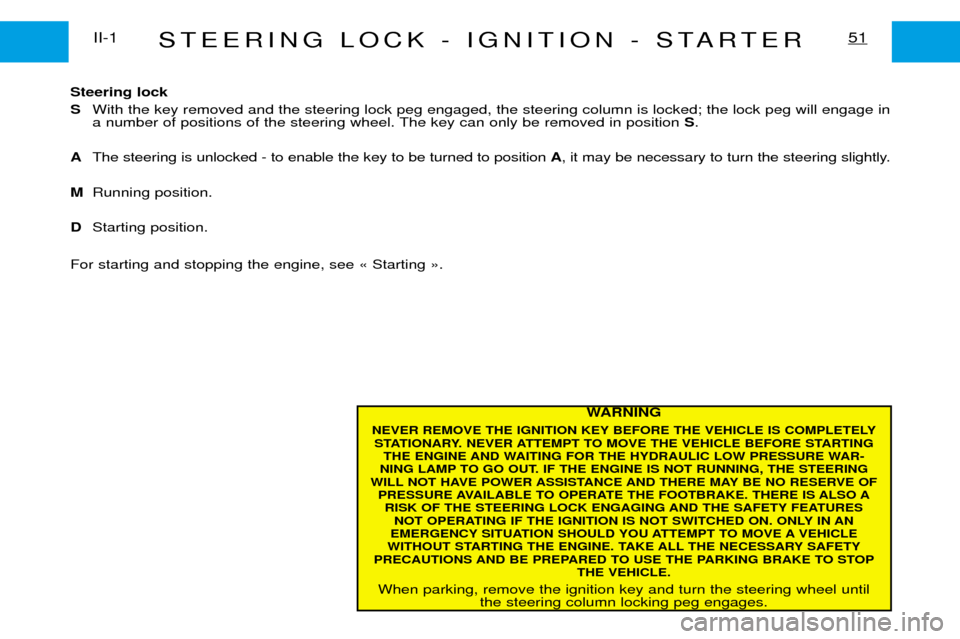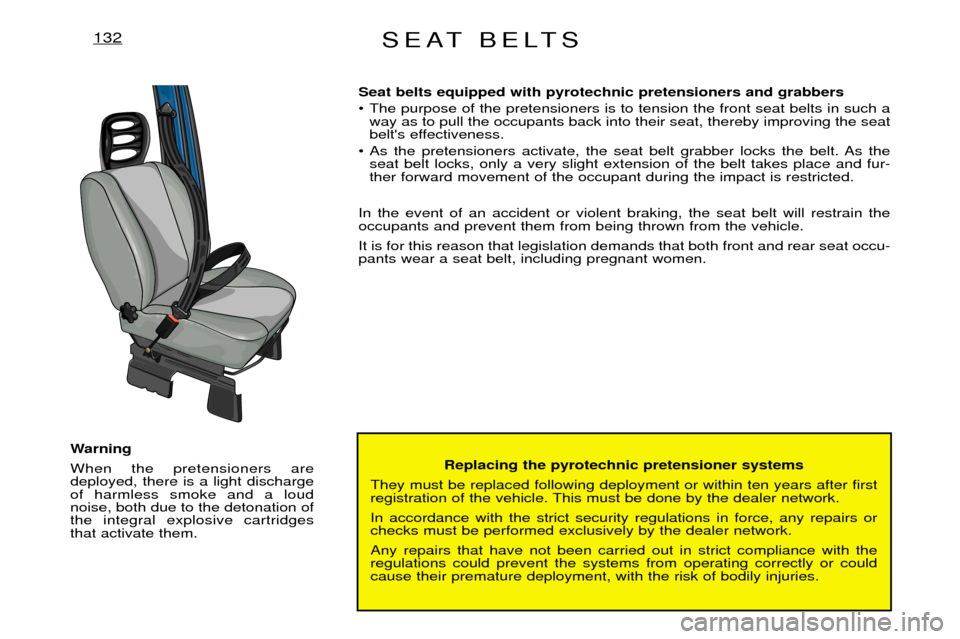Page 49 of 149
WINDOWS*I-16
46
ALWAYS PAY ATTENTION TO WHERE CHILDREN
ARE WHEN OPENING OR CLOSING WINDOWS.
Sequential control*
One touch on the switch to its first position offers partial opening of the driverÕs
window.
Pressing the switch to its second position fully opens or closes the window. Child safety precaution Always remove the ignition key when leaving the vehicle, even for short periods. Electric control The switches mounted in the roof
console control the vehicleÕs frontwindows.
Glazed or Combi versions Sliding side window in second row
To open, pull Aand slide the win-
dow towards the front.
To close, slide the window towards
the rear, then press Bto lock it.
* According to model or countryProtection fuses under the dashboardF5 - F28 - F29
AB
Page 64 of 149
STEERING LOCK - IGNITION - STARTERII-1
50
¥ S : Steering lock
To free the steering, turn the steering wheel slightly at the same time as tur- ning the key; avoid using undue force.
¥ A : Accessories
Allows certain electrical accessories to be used. The battery charge warning lamp illuminates.
¥ M : Ignition The following warning lamps should come on: battery charge, handbrake, oil
pressure, engine coolant temperature According to the specific version of
vehicle, the following warning lamps should also come on: Stop, ABS, Engineautodiagnostic, Preheating (Diesel), Front airbag. If one of these lamps fails to light, it could indicate a fault in the system concerned. ¥ D : Starter Release the key as soon as the engine has started. Never operate with the engine running.
These warning lamps are tested with the ignition key in the ignition on position.
Page 65 of 149

STEERING LOCK - IGNITION - STARTER51II-1
WARNING
NEVER REMOVE THE IGNITION KEY BEFORE THE VEHICLE IS COMPLETELY STATIONARY. NEVER ATTEMPT TO MOVE THE VEHICLE BEFORE STARTING THE ENGINE AND WAITING FOR THE HYDRAULIC LOW PRESSURE WAR-
NING LAMP TO GO OUT. IF THE ENGINE IS NOT RUNNING, THE STEERING
WILL NOT HAVE POWER ASSISTANCE AND THERE MAY BE NO RESERVE OF PRESSURE AVAILABLE TO OPERATE THE FOOTBRAKE. THERE IS ALSO ARISK OF THE STEERING LOCK ENGAGING AND THE SAFETY FEATURES NOT OPERATING IF THE IGNITION IS NOT SWITCHED ON. ONLY IN AN
EMERGENCY SITUATION SHOULD YOU ATTEMPT TO MOVE A VEHICLE
WITHOUT STARTING THE ENGINE. TAKE ALL THE NECESSARY SAFETY
PRECAUTIONS AND BE PREPARED TO USE THE PARKING BRAKE TO STOP THE VEHICLE.
When parking, remove the ignition key and turn the steering wheel until the steering column locking peg engages.
Steering lock
S With the key removed and the steering lock peg engaged, the steering column is locked; the lock peg will engage in
a number of positions of the steering wheel. The key can only be removed in position S.
A The steering is unlocked - to enable the key to be turned to position A, it may be necessary to turn the steering slightly.
M Running position.
D Starting position.
For starting and stopping the engine, see Ç Starting È.
Page 69 of 149

BRAKES55II-4
ABS - Anti-lock Braking System* This system improves vehicle safety by preventing the wheels from locking under emergency braking or when
braking on surfaces offering poor adhesion.
It thus also allows control of the steering to be retained. The operation of the various electronic components of the system is continuously monitored, both before and during your
journey. On switching on the ignition, the ABS lamp will light for approximately two seconds. If it stays on or lights when
driving, the ABS computer has detected a fault and has disconnected the ABS system. If the lamp lights whilst driving, it
again indicates that a fault has been detected and that the ABS system is inactive. In both situations, the normal braking
system is not affected and will continue to function as a conventional braking system without ABS. Nevertheless, to re-
establish the full safety features of the ABS system, It is recommended that the vehicle be examined by a dealer as soonas possible.
On slippery roads (loose stones, snow, ice, etc.), it is imperative to drive with caution.
* According to model or country
Protection fuses under the dashboardF12
(under the bonnet)
MF4 (with ABS)
Page 75 of 149

GEAR LEVER61II-6
Starting position
The engine can only be started
when the lever is at position P or N.
A safety device ensures that starting is impossible in the other positions.
Park Do not engage until the vehicle is completely sta-
tionary. To avoid any
movement of the vehicle when par-ked, select position Pand apply the
handbrake firmly. Check that theselector is in the Pposition to ensure
that the driving wheels are locked. When leaving the vehicle, make
absolutely certain that the PARK orP position is selected.
Automatic gearboxes - safety mea-sures:
¥ The gear lever can only be disen- gaged from position Pif the brake
pedal is pressed down.
¥ An audible warning* sounds if the gear lever is not in position P
when a door is opened. Also works with the ignition switched
off. Reverse gear Engage only when statio- nary and with the footbra-
ke firmly applied. To avoid
any transmission snatch or harsh-ness, wait several seconds before
pressing the accelerator. Neutral Do not select this position,
even momentarily, whenthe vehicle is in motion.
Warning If N is selected inadvertently when the vehicle is moving,allow the vehicle to stop beforeengaging other functions.
* According to model or country
Page 78 of 149

GEAR LEVERII-6
64
Operation in sequential mode Manual changing of the four gears:
- Selector on M,
- push the selector towards the Ç+È sign to engage a higher gear,
- pull the selector towards the ÇÐÈ to engage a lower gear.
A shift from D(automatic mode) to M
(sequential mode) is possible at any time.
After selecting a gear, do not leave your hand resting on the selector formore than ten seconds; risk of cancel-ling the sequential function Ð this issignalled by a flashing on the instru-ment panel. Contact your dealer network. Note:
Changes from one gear to
another are only achievable when conditions of vehicle speed and
engine speed allow. If they do not,then the laws governing operationof automatic gearboxes come into
play. Stationary or at very low speed, the gearbox automatically selects gearM1. The programme Ç ❄
È (Snow) does
not apply in manual mode. Operational anomalyAny operational disturbance is signalled by a flashing in the dis-
play. In this case, the gearbox will opera- te in emergency mode (third gear is
blocked). You will feel a bump whenshifting from
Pto Rand from Nto
R ; this snatching does no harm to
your gearbox. Do not exceed 60 mph.Contact your dealer network.
Page 79 of 149

SEAT BELTS132
Replacing the pyrotechnic pretensioner systems
They must be replaced following deployment or within ten years after first
registration of the vehicle. This must be done by the dealer network. In accordance with the strict security regulations in force, any repairs or checks must be performed exclusively by the dealer network. Any repairs that have not been carried out in strict compliance with the regulations could prevent the systems from operating correctly or couldcause their premature deployment, with the risk of bodily injuries.
Warning When the pretensioners are deployed, there is a light dischargeof harmless smoke and a loudnoise, both due to the detonation ofthe integral explosive cartridgesthat activate them. Seat belts equipped with pyrotechnic pretensioners and grabbers
¥ The purpose of the pretensioners is to tension the front seat belts in such a
way as to pull the occupants back into their seat, thereby improving the seat
belt's effectiveness.
¥ As the pretensioners activate, the seat belt grabber locks the belt. As the seat belt locks, only a very slight extension of the belt takes place and fur-ther forward movement of the occupant during the impact is restricted.
In the event of an accident or violent braking, the seat belt will restrain theoccupants and prevent them from being thrown from the vehicle. It is for this reason that legislation demands that both front and rear seat occu- pants wear a seat belt, including pregnant women.
Page 80 of 149

SEAT BELTS133
- Make all seat belt adjustments when the vehicle is stationary.
- Do not allow the seat belt to rest on any hard or breakable objectsin your pockets.
- Do not use any type of clip or clamp which would prevent the seat belt from tensioning correctly.
- Never use the same seat belt for more than one occupant.
- Never carry a child on your lap.
- Check the seat belts and attachments regularly for cleanliness.
- Have the seat belts checked periodically by your dealer, especially after an accident (even if only minor).
To put on the seat belts: Grip the buckle and withdraw the seat belt smoothly across yourbody making sure that it is not twis-ted. Insert the buckle tongue into itsfixed section of the buckle and pushhome to lock. Pull to check that issecurely located. The lap strap must be positioned as low as possible across the pelvisand should be as tight as possible. The backrest of the seat should be as close to vertical as possible toavoid any risk of slipping beneaththe belt in an impact. SEAT BELTS FRONT The front seats of your vehicle are fitted with height adjustable inertiareel seat belts and pretensionerand grabbing devices.
Two of the three rear seat belts are of the inertia reel type. The wearing of seat belts is obli- gatory for all the occupants ofthe vehicle.
To offer the maximum degree of protection, it is essential that the
seat belt is worn correctly.
Adjusting the height of theupper seat belt anchorage The shoulder strap must be positio- ned across the centre of the shoul-der (see diagram). Never allow theseat belt to run across the neck norunder the arm.